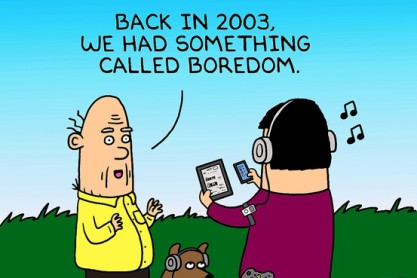
Adaptation is something species do over many generations, but in the entertainment industry, especially in recent years, advances in viewing technology have been arriving at a speed that seems to outpace many attempts to keep up. If adaptation in this arena is too slow, any such slowly adapting product or service will rapidly find itself in the crosshairs of something beyond simply being forced to change faster, namely the likelihood of a newcomer providing a stand-alone replacement.
In the current booming environment of startups and tech-pioneers, if a solution to a problem doesn’t exist, rather than wait for that product or service to be rolled out by the establishment, people are now far more capable of putting in some effort and sweat to build it themselves, often creating a livelihood providing to others what they originally made for themselves. This is even more true today than in the past as huge segments of the younger population are shaping the discussion by simply ignoring what they are told they can and cannot do and are instead just doing it to a level that would make Nike proud.

Now how does this tie in to entertainment? We all know that the largest segment of traditional “Hollywood” is still largely run by well-entrenched establishment executives with long track records and huge budgets, but it seems they are often not doing terribly well at keeping up with changes in the market. What they see as “emerging trends” to study and track, I would rather tend to call paradigm shifts in production, distribution, and viewing.
There is now a generation that has never had to watch a full-length commercial. A group who doesn’t watch movies in theaters, but rather on giant home entertainment systems with incredible sound systems. And of course the portable content viewers, for whom watching a video or show on their laptop, tablet, or even cell phone is as natural as walking to class. To them those statements are obvious and self-evident, but to the less bleeding edge execs, what is as plain as day to younger people often needs to be spelled out for the older ones.

The thing is, much of the content younger audiences are being marketed from main stream sources still comes from those who watch movies in theaters, who grew up on a few dozen channels of TV, and who are reluctant to let go of the old way of thinking that several minute commercials blocks breaking up a show is the natural way to pay for production.

The marketplace is full of people who have, in their pockets, access 24/7 to a huge variety of content, most of it largely if not entirely commercial free. The commercials they do find themselves forced to sit through are tiny snippets and not 2-4 minute blocks. YouTube, Hulu, Vimeo and the like offer bite-size entertainment with minimal ad interruptions, and much of it is produced by peers rather than out of touch studio heads.
It is likely that for the foreseeable future there will continue to be a solid demand for high-end, high-production value product. Even with home studio technology, you just can’t produce The Avengers or Harry Potter on a C-300 or GoPro, but there are a ton of great films and programs being made for a limited budget which have surprisingly good production value. Conversely, free is not always better, and a lot of really bad filler material is out there as well. While quality sometimes rises to the top, the sheer amount of product out there requires a bit of sifting to discover the hidden gems. Fortunately an active social media network can help steer like-minded people to entertainment they’d likely enjoy. We saw it happen with music, and it is happening more and more with other entertainment as well.

Anyone with a camera can make a short, shoot a movie, or put out a show, and many of the more talented content creators make a very good living off of viewer donations and views/ad revenue shares. The donation aspect is particularly worth noting. If you produce a product people like, the younger generation has really latched onto something great, namely supporting the content you like directly. I don’t only mean a Go Fund Me or Kickstarter campaign, but just chipping in on a case by case basis. A dollar a month to support a show you enjoy times several thousand supporting viewers can effectively let the viewing audience become the defacto producers of a show. It’s crowd sourcing at its best. No middle men re-directing funds to their pet projects, no great shows canceled by an out of touch executive (ahem, Firefly). The audience speaks with their dollars, and when directly helping those who give them what they enjoy for less than the price of a cup of coffee, many have no qualms about chipping in and supporting shows they enjoy.
Just look at how successful Alan Tudyk and Nathan Fillion were with their crowdfunded series Con Man.
Yup, they raised over $3 million on their Indiegogo campaign.
A final thing to consider is that with GoPro and Blackmagic making amazing and affordable cameras that shoot amazing HD footage and are within reach of a lot of aspiring directors and cinematographers, it is rapidly becoming a time when anyone can become a content creator, and what will set them apart is no longer the ability to somehow afford a great camera but rather the eye and skill of the shooter behind it.




